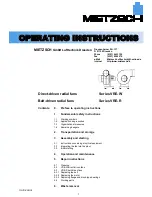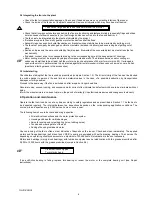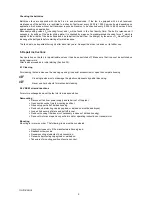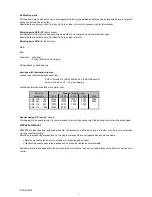
1.3 Organizational measures
All operations with the fan must be carried through by those operators only who are well trained and reliable.
Operation with electrical units (motors, control and regulating devices) must not be carried through but by qualified
persons (see also DIN VDE 0105 or IEC 364).
Repairs of explosion-proof fans must not be carried through but by the manufacturers or after consultation with
them.
Maintenance intervals have to be specified by the user in consideration of use conditions and, if needed, after
consultation of the manufacturers. The fan must be thrown out of operation and repaired in cases of changes that
might affect safety (such as uneven running, abnormal noise, damages and defects that are visible from outside).
Original spare parts only have to be used for repair.
Changes of the fan are impermissible if they lead to safety risks.
The fan must not be thrown into operation unless its state is reliable. This means that all protective and safety
systems (such as electrical motor protection, belt guard, in some cases protective gratings or strainers) have to be
existing and functioning and that the fan has been integrated into the plant as indicated by the project.
1.4 Remaining dangers
The fans are of reliable design. Their production is supervised by a quality monitoring system. A certain remaining
danger, however, cannot be excluded. This can be caused e.g. by a broken runner, especially in case that the
conditions of application (see Section 1.2) are violated. Consequently, the fan's vicinity must be secured so that
persons and objects cannot be endangered in the case of a possible average.
A strainer can avoid that housing destruction leads to danger to the vicinity by fragments, to be sure, but it is no
absolute safety in cases of average.
It cannot be excluded generally that small quantities of the conveying medium escape at the shaft feedthrough so
that suitable safety measures should be taken according to dangerousness of the gas.
The permissible immission limit for noise specified in relevant prescriptions for labour protection may be exceeded
especially in cases of fans of larger power and arrangement in small and live rooms. Persons in such rooms must
be protected by suitable measures from injuries by noise.
2. Transportation and storage
Loading work has to be carried through by experienced persons only. Use hoisting means and load take-ups of
sufficient load-carrying capacity. If transporting the fan take it by its steel components only.
If transporting the fan by crane fasten suitable load take-ups to the base. Larger fans have two bores in their sheet
metal base for fastening load take-ups.
Transportation eyes of the motor must not be used for fan suspension.
The fan must be transported in its working position (without vibration isolators put underneath) and protected
reliably against getting out of place, tilting, and collision. If selecting means of transportation take care that plastic
fans are susceptible to shocks.
In the case of outdoor storage protect the motor and fan inside against direct atmospheric influence.
3. Assembly and starting
3.1 Instructions concerning electrical equipment
The electrical equipment has to be installed by experts according to standards.
Every motor has to be connected to the power supply system through a motor protection system. Bimetallic
releases have to be set to rated current. In cases of pole-changing motors install either two separate motor
protection switches or a thermal winding protection (PTC resistor --> special design TS).
If the motor speed rate is controlled by voltage dividers or frequency
i
nverters a conventional bimetallic switch
offers incomplete motor protection only. A thermal motor protection (PTC resistor --> special design TS,
thermocontacts) is necessary in that case. Also the protection by calculation of I²t, which is very often integreated
in frequency
i
nverters, can be used.
Electrical connection has to be as shown in circuit diagrams in the terminal box or in the installed and wired repair
switch.
Check the data of electrical connection (voltage and frequency). Supply voltage in cases of star-delta switches
must be the same as the lower voltage on the type plate.
The fan must not be started before resistance of the winding relative to earth has been measured. Dry the winding
if this resistance is less than 0.5 M .
Check the direction of fan rotation by briefly starting it. It must coincide with the direction indicated by the arrow on
the fan.
After starting measure the current taken by the motor.
!
!
3
!
OI-VRE 05/02


























